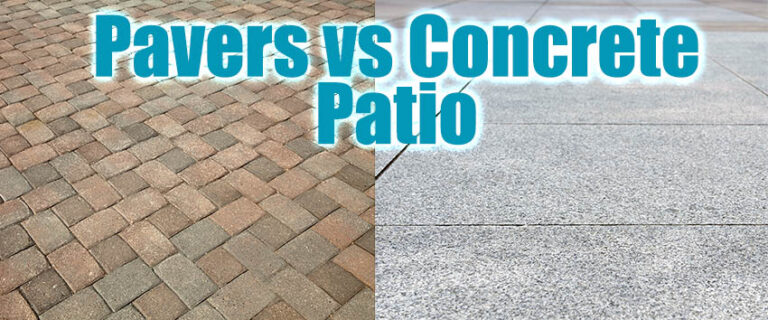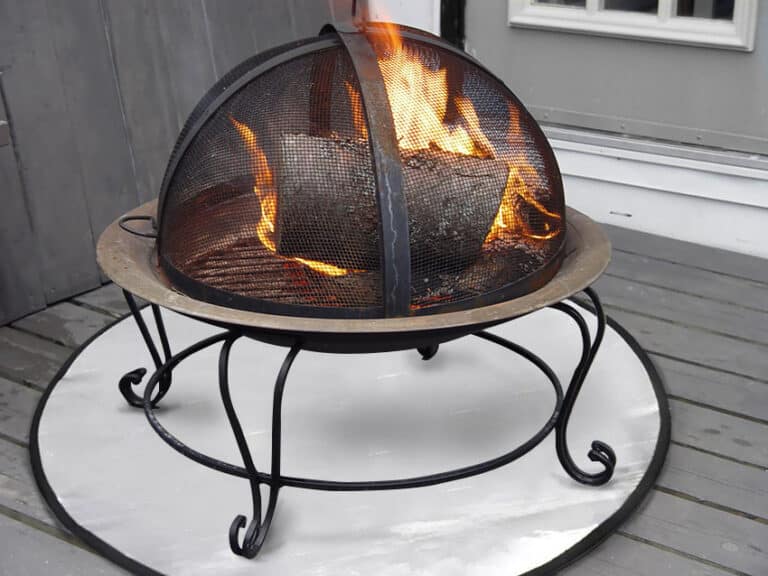Stamped Concrete Pros and Cons
Here we share our guide to stamped concrete pros and cons including what it is, cost, maintenance and design considerations.
Stamped concrete is a popular option for patios, pool decks, walkways, driveways and even interior floors. The material can be crafted to replicate the look of other more expensive type of flooring such as natural stone or brick.
What is Stamped Style Concrete?
Also called textured or imprinted concrete, stamped concrete is a paving method that can imitate the look of more expensive pavement at a lower cost. See more stamped concrete patio ideas here.
A slab of concrete is poured three or four inches thick and allowed to partially dry. Before the drying process is complete, stamps are used to imprint a design on the surface of the concrete.
Stamped concrete can be used inside the home, but it is most commonly used for exterior surfaces. Patios, fire pits, and walkways are just a few of the applications for this versatile and attractive material.
A seamless stamp adds texture to the concrete without creating the look of individual tiles, bricks, or stones.
Seamed stamps include faux grout lines or seams, which separate the concrete slab into smaller shapes.
The shapes can be simple, such as uniform squares or rectangles, or more complex, such as ogees, fans, or cobblestones. Texture can also be added to more closely resemble the intended material, such as brick or flagstone.
There are two options for changing the color of the concrete. If a uniform color is desired, stain can be added to the concrete mixer.
If variations in color are necessary, the concrete can be hand stained to complete the illusion of individual stones.
The stamp itself is made from a flexible material that is lifted and lowered repeatedly to achieve the desired pattern.
While it’s possible to do this project yourself, it does take a fair amount of skill and practice, so it might be best to leave it to the professionals.
Some consumers desire the look of irregularly sized and randomly placed stones for their patio or walkway. This can also be achieved with concrete stamps, but be aware that most stamps are only two or three square feet, so the random effect is limited.
Oversized stamps, which are closer to five square feet, do a better job of creating the illusion of randomness.
Stamped Patio Concrete Pros
Adding a patio to your home increases your enjoyment of your outside space and makes your home feel larger.
Refinishing an existing patio has excellent return on investment when it comes time to sell your home. Stamped concrete is an easy and quick way to create a patio that all members of your household will enjoy.
The designer options for customization are virtually unlimited. This is a big advantage as the pattern, texture, and color can all be altered to meet your exact specifications. See pictures of different concrete finishes here.
Stamped concrete needs to be sealed after installation, and resurfaced every five to seven years. Other than this, it requires no maintenanceand should last for at least 25 years.
A stamped concrete patio can be installed in a single weekend, as opposed to pavers or stone work which can take weeks.
A non-skid additive can be used during the concrete mixing process to make the surface slip resistant. People with mobility challenges often find it easier to navigate the even and uniform surface of stamped concrete when compared with pavers, stone, or tile.
Stamped Patio Concrete Cons
The main drawback to stamped concrete is that it is difficult to repair. In colder climates, cracks may appear in the surface as the ground shifts due to freeze/thaw cycles.
Deicing salts can also damage stamped concrete. Should the slab crack or become damaged, repair is not usually possible. Instead, the entire surface must be removed and repoured.
To combat cracking, look for an installer who will place control joints every few feet. Control joints are gaps in the poured concrete that allows room for expansion and contraction.
Stamped concrete is not intended to withstand the weight of parked vehicles. While you may find an installer willing to create a driveway or carport out of stamped concrete, you should expect the lifespan of the driveway to be shorter, and prepare yourself for cracks to appear.
Another disadvantage is that repairs may be difficult to match with the original color and pattern of the surface according to Caltrans. In addition, the installation is more labor-intensive for homeowners or contractors than other types of concrete.
Is Stamped Surface Concrete Cheaper than Pavers?
Usually, but not always. There are a number of variables that must be considered when comparing the cost of stamped concrete to pavers. First, let’s look at the relative costs of labor and installation.
Stamped Design Cost
Stamped concrete with a simple design, using only one pattern and one color, can be had in some areas of the country for as little as $8 per square foot, ranging up to $12 per square foot.
More intricate or complex designs or multiple colors will raise the price — expect to pay between $12-18 per square foot. High-end designs that use multiple stamps, colors, and hand-staining methods start around $18 per square foot and climb from there.
An average patio measures 16 x 18 feet, or 288 square feet. For a simple stamped concrete design, expect to pay between $2,000 and $3,500.
A mid-range design can be achieved for between $3,500 and $5,000. When it comes to extensively customized and high-end stamped concrete, it could cost up to $8,000 to cover the same area.
Including labor and materials, expect to pay at least $10 per square foot to install pavers. Depending on labor costs in your area and the price of the materials you choose, the cost could be as much as $17 per square foot.
To cover a standard-sized patio in pavers, budget $2,500-$5,000 for materials and installation. Paver patio designs require more labor to install, since they must be laid individually. They also incur hauling costs, since they must be transported to the work site, whereas concrete can be mixed on location.
Stamped Decorative Concrete Maintenance
The upfront cost of a stamped surface isn’t the only factor to consider, there’s also maintenance. Pavers can be replaced individually should they chip, break, or crack, while a concrete slab would need to be removed and repoured.
However, keeping pavers clear, level, and weed-free is a bigger task than you might think. Many people prefer stamped concrete for its durability and as a low-maintenance alternative to pavers.
For maintenance you will need to consider the following:
- Regular sweeping with a broom to remove the accumulation of dirt, leaves and debris.
- Washing every couple of months with a mild detergent to help prevent staining.
- Cleaning up any stains immediately. A concrete cleaner product can be used for stubborn stains.
- Resealing every five to seven years to prevent fading due to sunlight. (More resealing may be necessary for high traffic areas)
- Use protective outdoor area rugs or pads to protect the surface from scratching.
- Fill in cracks as they appear using commercially available concrete repair caulk products.
Thinking long-term, pavers tend to last around 50 years, while stamped concrete has a lifespan of about 25 years, with appropriate maintenance and resurfacing.
Either pavers or stamped concrete will add to the curb appeal of your home and will likely increase its resale value.
See more types of patio designs on our gallery page.






